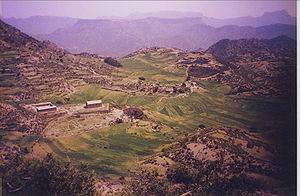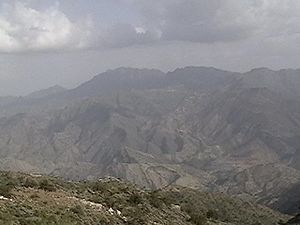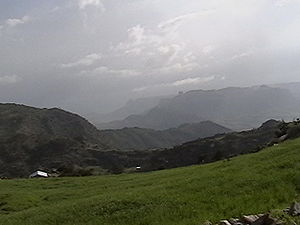
Irob people
Encyclopedia

Tigray Region
Tigray Region is the northernmost of the nine ethnic regions of Ethiopia containing the homeland of the Tigray people. It was formerly known as Region 1...
, Ethiopia. They speak the Saho language
Saho language
The Saho language is a Cushitic language of Eritrea and Ethiopia.-Overview:It is spoken natively by the Saho people who traditionally inhabit territory in Eritrea bounded by the bay of Arafali in the east, the Laasi Ghedé valleys in the south, and the Eritrea highlands to the west .This speech area...
, are Christians (Ethiopian Orthodox Tewahedo
Ethiopian Orthodox Tewahedo Church
The Ethiopian Orthodox Tewahedo Church is the predominant Oriental Orthodox Christian church in Ethiopia. The Ethiopian Church was administratively part of the Coptic Orthodox Church until 1959, when it was granted its own Patriarch by Coptic Orthodox Pope of Alexandria and Patriarch of All...
and Ge’ez Rite Ethiopian Catholic
Ethiopian Catholic Church
The Ethiopian Catholic Church is a Metropolitan sui iuris Eastern particular Church within the Catholic Church. Established in 1930, its membership includes inhabitants of Ethiopia and Eritrea....
), and mainly agriculturalists. Although the boundaries of Irobland is to an extent identical to the Irob
Irob (woreda)
Irob is one of the 36 woredas in the Tigray Region of Ethiopia. This woreda is named after the Irob people, who are the predominant ethnic group living there...
woreda, it is bordered by the following areas: Dabri-Mela to the north, Hado to the east, the Afar Region
Afar Region
Afar is one of the nine ethnic divisions of Ethiopia, and is the homeland of the Afar people. Formerly known as Region 2, its current capital is Asayita; a new capital named Semera on the paved Awash - Asseb highway is under construction....
to the east and south, Shoumezana and Gulomakeda
Gulomahda
Gulomakeda is one of the 36 woredas in the Tigray Region of Ethiopia. Its name partly comes from the legendary Queen Makeda, also known as the Queen of Sheba. Part of the Misraqawi Zone, Gulomakeda is bordered on the south by Ganta Afeshum, on the west by the Mehakelegnaw Zone, on the north by...
to the west, and Saesi Tsaedaemba
Saesi Tsaedaemba
Saesi Tsaedaemba is one of the 36 woredas in the Tigray Region of Ethiopia. Located in the Misraqawi Zone at the eastern edge of the Ethiopian highlands, Saesi Tsaedaemba is bordered on the south by Wukro, on the southwest by Hawzen, on the west by Ganta Afeshum, on the northwest by Gulomahda, on...
to the south. The first two neighbors are Saho speakers and predominantly Muslim, the third are Muslim Afars, and the others are Tigrigna-speaking Christians.
History

Alitena
Alitena is a town in northern Ethiopia, located in the Misraqawi Zone of the Tigray Region. Alitena was the administrative center of Irob woreda until Dawhan was made the new center prior to 2003.- Overview :...
. Irobs trace their lineage to one man, Summe, son of Neguse Worede-Mehret, who according to the Irob oral history, migrated to the Irobland from Tsira'e in Kilite Awla'elo, a part of Tigray, about 700 years ago.
Despite their relatively small population, the Irob have been at the forefront of regional and national politics in Ethiopia. Starting with the Zemene Mesafint
Zemene Mesafint
The Zemene Mesafint was a period in Ethiopian history when the country was rent by conflicts between warlords, the Emperor was reduced to little more than a figurehead confined to the capital city of...
, the Irob family of Shum
Ethiopian aristocratic and court titles
Until the end of the monarchy in 1974, there were two categories of nobility in Ethiopia: the Mesafint or princes, hereditary nobles, formed the upper echelon of the ruling class; while the Mekwanint were the appointed nobles, often of humble birth, who formed the bulk of the nobility...
Agame Woldu dominated Tigrayan politics. The dynasty included Dejazmach Subagadis
Sabagadis
Sabagadis was a Dejazmach or governor of Tigray, a province in northern Ethiopia. He was the son of Shum Waldu of Agame, and a member of the Irob people.- Life :...
(whose rule extended to present-day Eritrea), Shum Agame Desta, Ras Sebhat Aregawi, and many others including Emperor Yohannes IV.
During the Italian invasion, Irob patriots, led by individuals such as Dejazmach Ayele Sebhat and Dejazmach Kassa Sebhat, contributed to the anti-Italian resistance movement from their base on Mount Asimba.
In more recent times, many Irobs, such as Dr. Tesfay Debessay, who was a leader of the Ethiopian People's Revolutionary Party
Ethiopian People's Revolutionary Party
Founded in April 1972, the Ethiopian People's Revolutionary Party was a prominent Marxist-Leninist organization in Ethiopia during the 1970s. It is also known as "Ihapa" from the acronym in Amharic...
(EPRP), played very important roles in the struggle waged against the feudal regime of Emperor Haile Selassie I and the subsequent dictatorial junta led by Colonel Mengistu Haile Mariam
Mengistu Haile Mariam
Mengistu Haile Mariam is a politician who was formerly the most prominent officer of the Derg, the Communist military junta that governed Ethiopia from 1974 to 1987, and the President of the People's Democratic Republic of Ethiopia from 1987 to 1991...
.


Lifestyle and Culture
The Irob are divided into three major subgroups or Are (House): Adgadi-Are, Buknaiti-Are and Hasaballa. The Adgadi-Are and Hasaballa are predominantly Orthodox Christians, while Bouknaiti-Are consist of Catholics.The Irob economy is primarily based on agriculture, including animal husbandry. The region is also renowned for its excellent honey. In fact, the Miess/Tej
Tej
Tej is a mead or honey wine that is brewed and consumed in Ethiopia. It is flavored with the powdered leaves and twigs of gesho , a hops-like bittering agent that is a species of buckthorn...
(honey-wine) made from the honey is praised throughout the region for its quality.
In general, the Irob are a bi-cultural community. With their Saho-speaking neighbors, they share a common language and certain social structures, such as a clan division system called Mela, and the title Ona for their regional leaders. Many other cultural practices, including wedding ceremonies, dress, dance, and food; however, are more similar to their Tigrigna-speaking neighbors.
Irobs also have distinctive customs. For example, they have an elaborate poetry-telling tradition called Adar. Also, the Irob men have a dance/step routine called Hora and Alkafo, which was traditionally performed in preparation for battles and still commonly displayed during weddings and other ceremonies.


